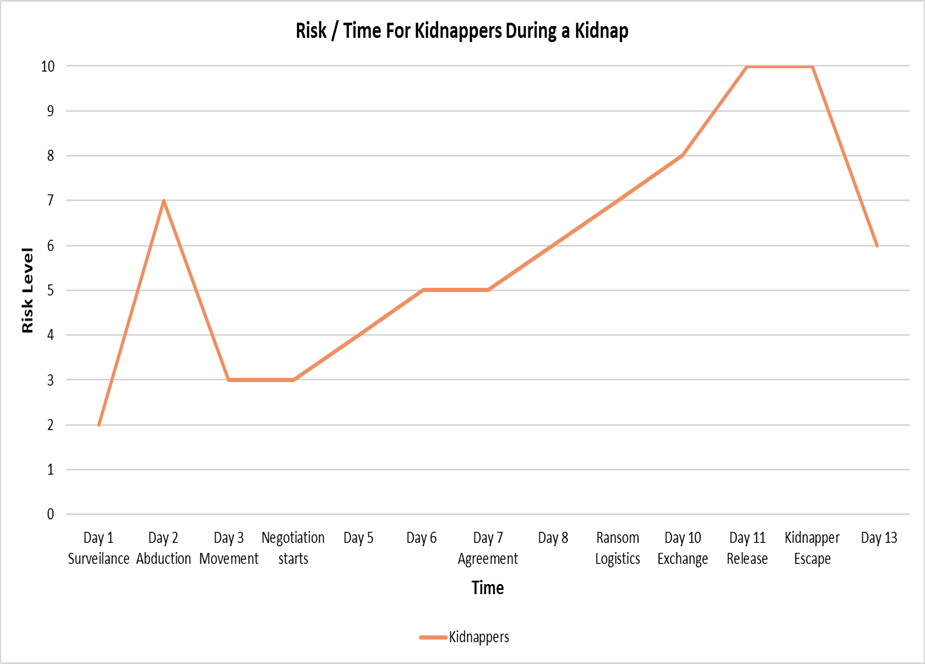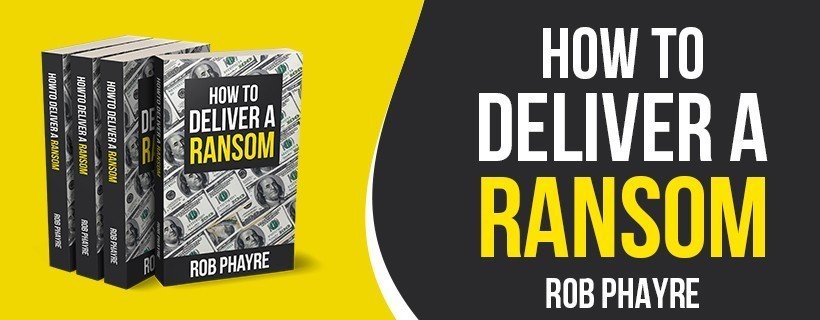We all know the kidnap for ransom business is risky, both for the victims and the kidnappers, but just how risky is it? In this article we will discuss the risk versus reward debate for the kidnap business model.
The following text is an excerpt from How To Deliver A Ransom, a true crime, non-fiction look at the whole kidnap for ransom business. Links to order are here: www.howtodeliveraransom.com

How does the risk increase over time?
On Day 1, the kidnappers start off with a low level of risk, which is a residual from their previous crimes. It’s logical that the more crimes they have completed, the higher the residual risk, until they eventually get caught because they are pushing their risk level too far.
Let’s assume that on Day 1 the kidnappers are in surveillance mode, though of course it may start several days before the actual abduction. As soon as they are conducting surveillance they are exposed. The more time they spend observing, especially for well protected targets, the likelihood of them being identified increases. If on the other hand, the victim is a target of opportunity, the surveillance period may only be a matter of minutes.
Immediately during and after the abduction itself, there will be a period of exposure where a member of the public may have called the police. It might be that a vehicle license plate number is reported, a description captured by a witness or an image recorded on CCTV. There is a very short window where risk exposure increases as the kidnappers and victim move to a pre-planned safe location.
The kidnappers risk exposure reduces for a brief period until they start communicating. There are lots of ways of communicating, depending on how technically savvy the kidnappers are. Over the next few days, as the negotiation continues there are more and more opportunities for the security services to identify the kidnappers’ location, and that increases the physical risk to the kidnappers.
As the negotiation concludes, the kidnappers will start to show some vulnerabilities. On exchange day, one of the gang members is going to have to collect the ransom. Ultimately, the collection point and date are going to be a fixed event. Sure, a little misdirection and guile can reduce the risk, and in large kidnap gangs, low level cut outs will be used to reduce the risk to the leaders, but someone will have to show their face.

Is trust an issue during a Kidnap for Ransom?
Even if a cut out is used, the person who collected the money is going to have to meet up with the rest of the kidnappers at some point. In mature gangs, where trust isn’t an issue, the money could be held somewhere else for several days. It never has to go anywhere near the victim, and so the money drop doesn’t become a link to the victim’s location.
During the delivery phase, it’s not just the risk of attack or capture by the security services. There is an issue of trust amongst the kidnappers too. Large sums of money can quickly erode trust, especially in the ‘one and done’ type mega-deals. It’s entirely possible for the kidnappers to double cross each other. Experience says that if that happens, the risk to the victim increases too.
The next event where the kidnappers are exposed and are at considerable risk is the release of the hostage. With effective synchronisation and planning, the risk can be managed, but the detail of that is not for open publication here. Ultimately, the hostage needs to be left in a public place where they can make their way to safety.
When will the security services intervene in a Kidnap for Ransom?
As we have seen, once the hostage is confirmed as safe, that is the point where security services may strike. Safe-houses, remote locations, the money location and any intermediaries can be swept up. As a commercial response provider, that is not your problem. If that has not happened, then after a day or so, the risk to the kidnappers reduces and their planning cycle can start again.
We have already described how in some countries, where kidnap is common, a professional kidnap gang might be running two or three projects at a time. All of those projects are likely to be out of sync and so the risk exposure level to the kidnappers remains consistently at an extremely high level for a long time. In those situations, it could be that it’s a negotiation for another victim that goes wrong, that ultimately impacts negatively on your particular victim.
What are the impacts if kidnappers are caught?
If you get caught, what happens then? Well, you might go to prison for a long time, or it’s another opportunity to get killed. In some countries you can still be hung for kidnapping. Surprisingly in fact, there are more than 30 countries globally with the death penalty still in place for kidnappers. Most of those are in the Middle East and Asia. So, the penalties are pretty solid if you are caught and if you cannot bribe your way out of it. So we can see, the likelihood of getting caught, and the impact, vary hugely from country to country.
If they don’t get caught after their first case, the simple fact is that the life of crime that they have adopted is going to continue, until the day that the risk reward equation that we spoke about earlier fails them.
They will either make a mistake and get killed during a security services operation, or if they are lucky and only get caught, they face prison, or execution. Very few will eventually work out that the risk is not worth the small rewards in time to stop and not get caught.
Are there ever really successful kidnappers?
If a kidnapper tries to aim for the big leagues, in a country where the security services are proficient, then they will draw undue attention to themselves. Vast resources will be expended trying to catch them, and they will eventually get caught. They get fifteen to life in prison, or as we mentioned before, death by hanging.
During the peak of Somali piracy, a large number of pirates were caught at sea by the international naval coalition. That resulted in pirates being taken to many different countries depending on which nationality of vessel picked them up. There are still Somali pirates in prison in the USA for example. After a while though, a deal was made to send most of them to high security prisons in Kenya. It’s a lot cheaper to do that there than pay the considerable sums to put them in prison abroad.
Finally, as mentioned, there is the risk of double cross, and a falling out amongst thieves. Sometimes it doesn’t need any external parties to start harming kidnappers. With a large enough sum of money, they might just do it themselves.
Very, very few ever make it to retirement and quit the business in time. A life of kidnap for ransom related crime nearly always catches up with them.

Case Study: Kidnap for Ransom – Julius Caesar
Sicilian pirates kidnapped the soon to be emperor when he was twenty-five years old. Caesar apparently laughed at how small the ransom demand was when it was made. He told the pirates to double it. At the same time, he threatened to seek revenge when he was freed. He was true to his word. The ransom was paid, and after his release he sent a small fleet of ships to hunt for the marauder’s. Those who were not killed during the battle were captured and eventually crucified.
Somali Piracy Incidents – Rumour or Fact?
‘In about 2011 during the peak of Somali Piracy, a story began to emerge of an incident that occurred at sea. A warship, which was working independently of the international coalition which was trying to defeat piracy, came across a pirate skiff at sea. They pulled alongside the skiff and arrested the Somali pirates. The skiff was then stripped of its fuel, the satellite phone, and its food. The pirates were then placed back on board the skiff. It was the middle of the Indian Ocean and the warship sailed away. It certainly wasn’t an ethical thing to do, but it came at a time when piracy was peaking. As a deterrent, the story was leaked discretely. Who knows if it is true or not, but you can guarantee that the other Somali pirates learned about it.
Shortly after that, there was another incident, this time with a Russian warship. As the warship came along side, the pirates onboard decided to fire a Rocket Propelled Grenade or RPG at the warship. That was a pretty stupid thing to do, but it was perhaps driven by the rumour of the previous incident. Entirely legitimately, the warship fired back in self-defence with its 130mm gun. 40 high explosive rounds a minute made short work of the pirates in their tiny wooden skiff.’
The above article is an excerpt of How To Deliver A Ransom, by Rob Phayre.
Coming in February 2025 – Pre-order now at all good bookstores.

Amazon: https://amzn.to/3ZGIypk
Smashwords: https://www.smashwords.com/books/view/1659823
Barns and Noble https://www.barnesandnoble.com/w/how-to-deliver-a-ransom-rob-phayre/1146650101?ean=2940180576002
I hope you enjoyed this article on kidnap for ransom. There are plenty more resources and articles available in the blog and on the main web page. Its all available here.
And finally, if you would like to connect with Rob on the topic of kidnap for ransom. Please ask any questions please approach through social media, he would love to here from you. Links are here.